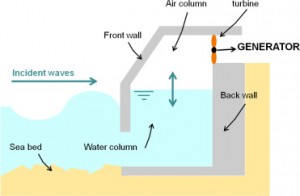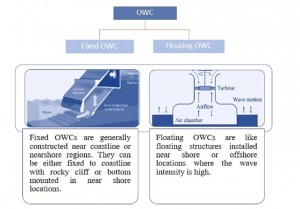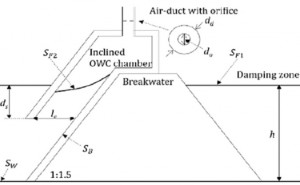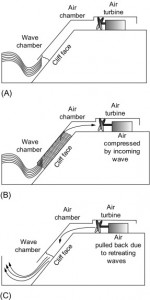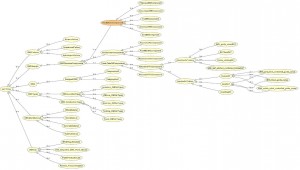Introduction
Oscillating water columns (OWC) are basically a type of wave energy converters that harness the inexhaustible wave energy and transform it into electrical energy. This structure functions mainly because it traps the energy from oscillation of sea side water waves inside an air chamber. There is enormous energy potential free of cost and around the clock. If the same potential is fully exploited it could satisfy worldwide domain of power. It is equivalent to power generated by 700-800 nuclear power stations. It is source of renewable energy with less environmental impact without emission of harmful greenhouse gases. The world first power station of this type was put in service in November 2000 at Scottish island of Islay. It indigenously provides climate and environment friendly energy. Right from that year most of the companies has been tirelessly working onto design efficient OWC models.
Oscillating Water Column
Types of Oscillating Water Column
There are various types of OWC. Its classification is mainly based on basis of locations and construction techniques. Based on locations it is categorized as shoreline, nearshore and offshore OWC. In regard with construction technique, OWC can be divided into two main types; (1) fixed OWCs and (2) floating OWCs . A fixed OWC consist of air chamber for primary conversion and an air turbine for secondary conversions. The floating OWC consist of cylindrical floater pierced by a hollow cylinder open at bottom to sear water and top to the pneumatic chamber. Unlike fixed OWCs, floating OWCs are moored to the seabed. Fixed OWC has more access from land therefore survivability index of it will be higher than floating. While floating OWC can harness more wave energy before the wave’s loss some of it energy due to frictional loss with the sea bed.
Types of Oscillating Water Column; Fixed and Floating Type
Components of Oscillating Water Column
An OWC consists of two essential components that are air chamber and power take off system along with breakwater structure . Air chamber is the collection chamber which is partially submerged hollow assembly made up of concrete, steel etc. Within air chamber the wave compresses the air column above the water column creating to and fro motion of air through turbine. The power take off system consists of air turbine and generator. The rotation of the turbine due to the air movement generates the electricity through the connected generator.
Cross Sectional of Inclined OWC
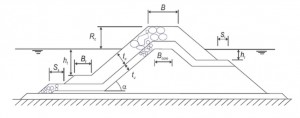
Cross Sectional Sketch of BreakWater
Working Principle
An OWC includes mainly a chamber partially filled with water and partially with air. The chamber opens up beneath to the ocean such that it communicates with the ocean as such. In the upper part of the chamber structure another opening is provided to draw air from outside and air turbine as well as generator is placed in the hollow cavity. When ocean water rushes through the underneath opening of the chamber, it raises the average water level, thus the air in the upper cavity gets compressed and it escapes through the orifice in the upper horizontal part of the chamber. When wave recede, the average water level decreases causing less air pressure in upper part thus enabling the sucking of external air inwards through orifice. The inner surfaces thus act like a piston that moves up and down. Air flow drives the turbine causing generator to produce electricity.
Air-driven turbines using the wave power: (A) upcoming wave starts filling the chamber; (B) air is compressed by rising water; (C) air is pulled back by retreating wave
Building Ontology for OWC
Ontological development of Oscillating column is really less explored realm, therefore research conducted in this domain, let to frame the competency questions answers which are specified below.
Purpose
- The study aims to Incorporate explored concepts related with design of OWC and Breakwater which can generate electricity even at times of low and high tide.
The study focusses on conceptual design parameters of the OWC, thus to emerge out with more efficiency-oriented design approach to harness the wave energy. While dealing sustainability aspect, it being an environment friendly OWC technique with less emission of greenhouse gases, the study facilitates the need of power generation through this approach. OWC is more cost-effective method compared with all other forms of electricity generation.
Scope
- This ontology includes concepts such as OWC types, physical components, possible materials, OWC Failure causes and possible OWC uses.
- More insight into the further exploration of ocean technology to harness wave energy.
Intended Users
- The intended end-users are the marine designers and marine engineers involved in the design process of OWC.
Intended Use
- The ontology is intended to bring forth information of parametric models used for designing Oscillating water column by design engineers and to create base ontology for research-oriented purpose as less ontological references are available for time being.
Taxonomy of Concepts
Physical Components
Domain research lead to create the various classes and subclasses that need to be focussed while creating the ontology for Oscillating Water Column. The major structural components of Oscillating Water Column are Air Chamber, Break Water and Power Take Off components.
- Air Chamber
- BreakWater
- Power Take Off
Main Material
Air chamber is basically made of concrete, steel and other materials as such. Where as Break water is made from rubbles.
- Concrete
- Steel
- Rubble
- Others
Types
OWC is categorised based on construction and location. In regard with construction type it is again classified into fixed and floating type. While considering location wise it is divided into nearshore, offshore and shoreline.
- Construction type
- Location type
Uses
- Cliff integrated Power Plant use
- Harness Wave Energy
- Whistling Buoys
Based on the data obtained in regard with the concepts involved within the domain, the classes and subclasses were formed with the protégé to create the ontology OWC.
Ontology of Oscillating Water Column
Download File
Ontology of Oscillating Water Column
